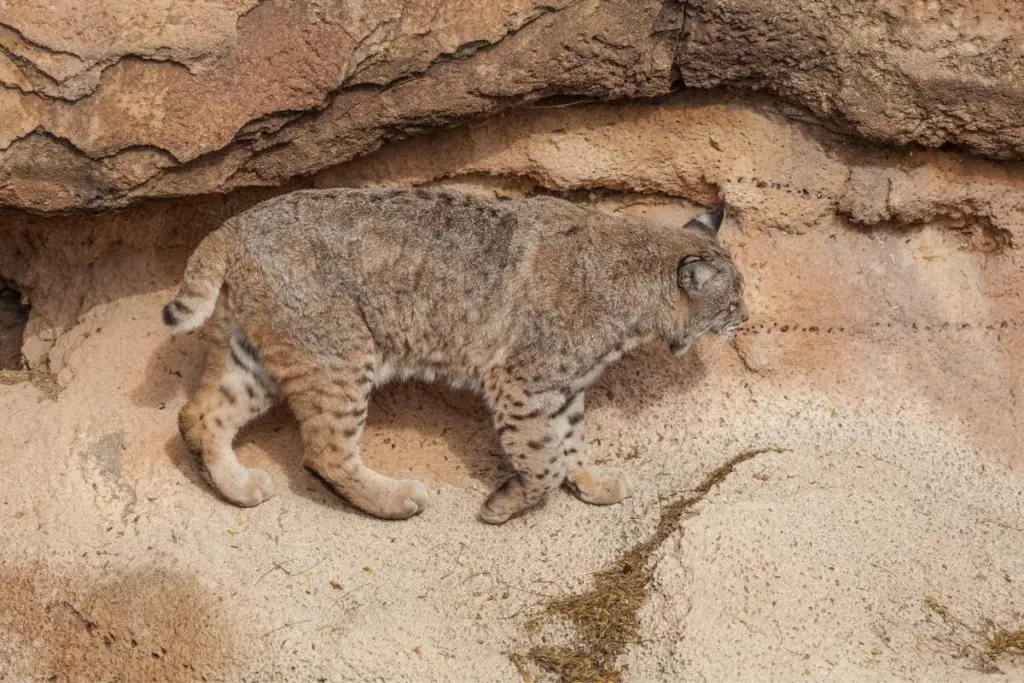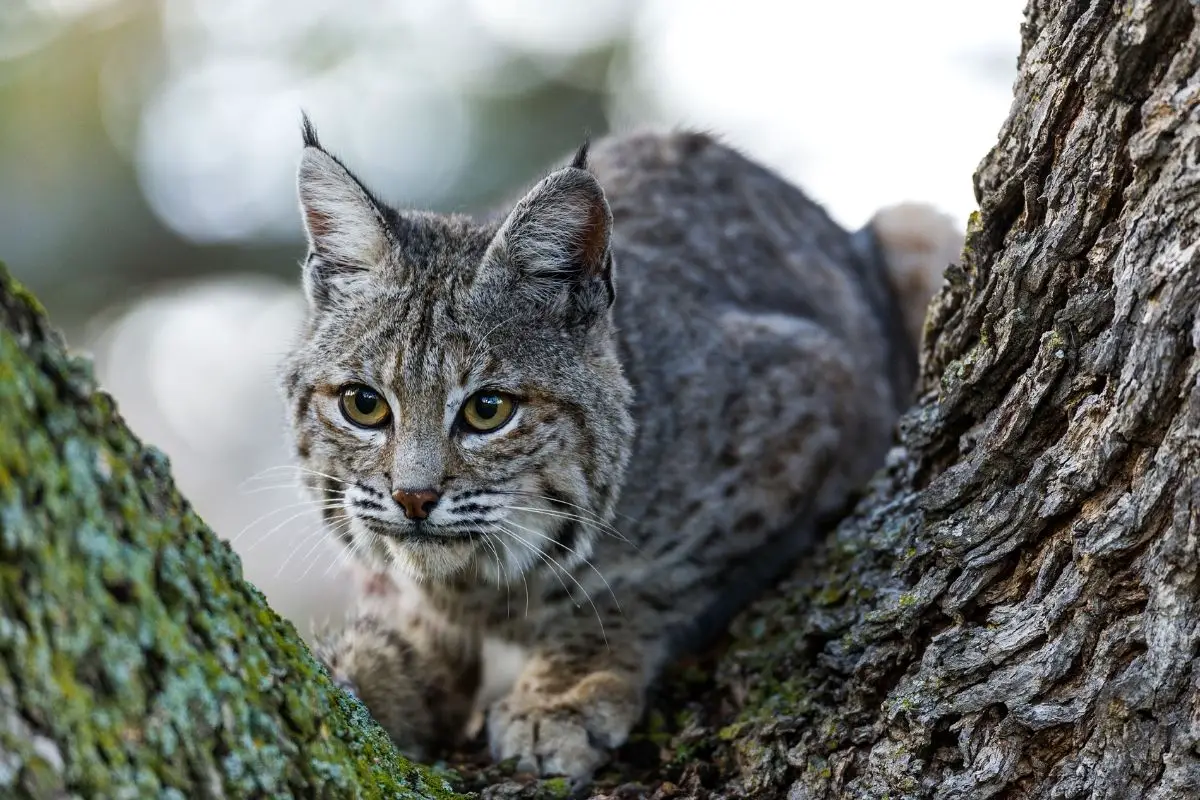I’ve encountered bobcats on multiple occasions, and one thing that I can tell you is that they usually stay pretty far away from humans.
You may live in a region where bobcats dwell. They could be nearby, lurking, and staying out of sight. If you’re curious, like me, you have probably asked yourself, where do bobcats live?
Bobcats exhibit remarkable adaptability, thriving in environments as diverse as boreal forests, coastal swamps, and desert scrublands. They’re equally comfortable navigating mountainous terrain, grasslands, and urban landscapes, showcasing their versatility and resilience.
Bobcats can be a predator to small household pets, so it is incredibly important to not let any of your pets roam around the types of regions or landmarks where bobcats live.
These regions may include but are not limited to rivers, caves, mountains, and lakes. Bobcats love to eat fish, rabbits, and other small animals by utilizing their hunting instincts and relying on their senses.
Bobcat Territory
Bobcats are widespread throughout North America. They live in regions that have water sources, food sources, forests, mountains, semi-deserts, swamps, farmland, and even urban regions. Some bobcats prefer dense vegetation, while others can survive in a desert environment.
The different regions where bobcats live can tell you a lot about how well they adapt to different climates. Bobcat territory spreads throughout northern parts of Canada, where there are cold climates, down to Texas, and Mexico, where they have semi-desert regions.
The bobcat has a home range, that it keeps to most of its life. The female’s home range is much smaller than the males. A female keeps a home range of around 7 square miles, while a male’s home range can be around 22+ square miles. Source.

How Do I Know If I Live Near Bobcats?
There are tons of different regions in North America where you might come across a bobcat. One unique characteristic about bobcats is the fact that they can efficiently adapt to the conditions that they are experiencing.
For example, bobcats can effectively live in several types of biomes and climates without sacrificing their lifestyle.
There’s a fairly good chance that you live near bobcats if you live near bodies of water that have a lot of fish. Bobcats can also be found in regions that have a lot of small animals like rabbits, squirrels, rodents, and gophers.
What Should I Do If I Live Near Bobcats?
If you have reason to believe that you live in a region that might be surrounded by bobcats, then you should probably take a few safety precautions around your property to make sure that nothing bad happens if one shows up on your property.
The first thing that you should do is try and block access to anything that you wouldn’t want a wild animal to have access to. This could be energy generators, yard equipment, or other materialistic objects that might be exposed on your property.
There have been some reported incidents of bobcats causing damage to various pieces of property.
More importantly, you should never let your household pets or young children be alone outside if you suspect that bobcats or other predatory animals might be nearby.
There have been reported instances where household pets have been injured or even killed when coming in contact with a wild bobcat. The same thing can be said for infants, babies, and children.
Read our article for Are Bobcats Dangerous?
Bobcat Habitat Preferences
Bobcats thrive in habitats with thick vegetation like forests, rocky canyons, and swamps where do bobcats live. Understanding what types of landscapes bobcats prefer provides insight into where do bobcats live across their range.
Bobcats are found where do bobcats live in areas that provide cover for hunting, denning and raising young. Their habitat preferences for rocky, brushy areas influences where do bobcats live.
I Iive in North Texas, and I have come across bobcats in open fields, wooden areas, and even in urban areas where there are not a lot of people, like abandoned lots.
Bobcat Range Expansion
Bobcats originally were found across much of North America, but in recent decades their range has expanded as they’ve adapted to developed areas near suburban and urban zones.
Examining how and why the bobcat’s range has grown provides insight into new areas where do bobcats live compared to their historic range. Where bobcats live today includes much more fragmented and human-altered habitat.
Threats to Bobcat Habitats
Development, logging, agriculture and other human activities can degrade the thickets, forests and scrublands that bobcats rely on.
Understanding the major threats to bobcat habitats demonstrates how human encroachment limits where do bobcats live and survive. Protecting their preferred natural landscapes is key for preserving areas where do bobcats live.
Bobcats in Suburban and Urban Areas
Bobcats are sometimes found near suburbs, parks, golf courses and other developed areas with remnants of natural habitat. Examining how bobcats use these human-dominated landscapes provides insight into how they are adapting to survive where do bobcats live near humans.
Where Do Bobcats Stay During the Day?
Because bobcats are mostly nocturnal, in the daytime they are going to be sleeping in their dens. However, bobcats are also crepuscular, which means they will hunt in the twilight hours and rare cases in the daytime.
The bobcat counts on a steady supply of prey animals, such as birds, rodents, squirrels, and other small game.
The environment where the bobcat lives may also affect the bobcat’s behavior. If they live near an urban area, they may adapt to morning or evening hours. When bobcats are kept in captivity, or raised as pets, they may take on the sleeping schedule of their caretakers.
How to Keep Bobcats Away From Property
As a property owner, you are probably curious about some of the methods that can be used to prevent bobcats from coming around your property.
Different types of fences can be effective, although some bobcats are still able to gain access to fenced locations. Electric fences are extremely popular, although they aren’t as effective as some other tactics.
Wild animal traps can be effective, although they don’t always work as intended. Traps can unfortunately also bring other unwanted wild animals onto your property and make your situation even worse. Your best choice is to fortify your fencing and any entrances underneath your home.
What Attracts Bobcats to Your Yard?
Most people will not want to attract bobcats to their yard. However, knowing what attracts them, can help your chances in deterring them. Bobcats live in places where there is plenty of small game for them to prey on.
If you think you have a bobcat nearby, then do not feed the birds or squirrels in your yard. If you do feed birds, keep the food dish from overflowing onto the ground.
It would be wise to feed your pets inside. Pet food could attract wild animals, such as bobcats, coyotes, and foxes. The last thing you want is wild animals competing for food that you leave outside.
Avoid having any fruit trees or plants, because they may attract rodents, which are a food source for bobcats.
Do Multiple Bobcats Live Together?
It is extremely rare to see bobcats living together, with the exception of a male and female bobcat breeding. They are known for being extremely territorial, so it would be extremely rare to see multiple bobcats living together in the same region.
In some cases, you might see multiple bobcats roaming through the same region within a short amount of time. It is believed that bobcats are slightly more willing to coexist with bobcats of the opposing gender rather than a bobcat of the same gender as their own.
Bobcat Populations by State
Some states track their bobcat populations, here are states that provide reliable information on bobcat populations, based on where they live.
| State | Bobcat Population Estimate (Year) | Data Source | Notes |
|---|---|---|---|
| Alabama | 20,000 (2015) | Alabama Wildlife and Freshwater Fisheries Division | Based on harvest data and expert opinion |
| Alaska | Abundance varies regionally | Alaska Department of Fish and Game | No statewide estimate available |
| Arizona | 20,000-30,000 (2012) | Arizona Game and Fish Department | Based on hunter surveys and track surveys |
| California | 25,000-30,000 (2005) | California Department of Fish and Wildlife | Based on track surveys and expert opinion |
| Wyoming | 10,000-15,000 (2014) | Wyoming Game and Fish Department | Based on track surveys and hunter harvest |
It is believed that there are around 2-3 million bobcats in North America.
U.S. States that are known to have bobcats:
- Alabama, Arizona, Arkansas, California, Colorado, Connecticut, Delaware, Florida, Georgia, Idaho, Illinois, Indiana, Iowa, Kansas, Kentucky, Louisiana, Maine, Maryland, Massachusetts, Michigan, Minnesota, Mississippi, Missouri, Montana, Nebraska, Nevada, New Hampshire, New Jersey, New Mexico, New York, North Carolina, North Dakota, Ohio, Oklahoma, Oregon, Pennsylvania, Rhode Island, South Carolina, South Dakota, Tennessee, Texas, Utah, Vermont, Virginia, Washington, West Virginia, Wisconsin, Wyoming.
Bobcats and the Ecosystem
Bobcats play a crucial role in maintaining ecological balance within their habitats. As mid-sized predators, they help regulate the population of smaller mammals like rabbits, rodents, and birds, which in turn can prevent these prey species from overgrazing vegetation or causing other disruptions. By controlling the population of these prey animals, bobcats indirectly influence plant growth and diversity.
Additionally, bobcats themselves serve as prey for larger predators such as coyotes and mountain lions. This interaction forms part of the intricate food web within ecosystems, contributing to the overall stability and resilience of the community. The presence of bobcats also promotes biodiversity by exerting pressure on prey species, which can lead to the survival of the fittest and the maintenance of genetic diversity.
Bobcats’ hunting behaviors, including their use of cover and stealth, can help shape the behavior and distribution of prey species, influencing their foraging patterns and habitat selection. Overall, bobcats act as keystone predators in many ecosystems, playing a vital role in maintaining the health and functioning of these complex natural systems.
Conclusion
If you are feeling concerned about possibly living in a region that could be surrounded by bobcats and other wild animals, then it is highly recommended that you consider some of the safety precautions that have been included within this guide.
Fencing your property and protecting your household pets and children are only a few of the important precautions that can be taken to protect you, your property, and your loved ones. Bobcats don’t have the natural desire to attack you or your property, they are likely just trying to find food for themselves or their baby kittens.
You should not immediately fear a bobcat if you discover that one is roaming around your property at night. All of the information within this guide is designed to help you prepare for the unexpected encounter of running into a bobcat.
By taking these precautions, you are much more likely to be able to live your life without the fear of a wild animal like a bobcat negatively affecting your life.
Have you ever seen a bobcat? Tell us about it in the comments below!
- Hero Farm Dog Survives Epic Battle with Coyote Pack - December 9, 2024
- The 10-Minute Bedtime Routine That Changed My Dog’s Sleep Forever - November 29, 2024
- Creating a Safe Space for Nervous Pets: Your Guide to Pet-Friendly Havens - November 25, 2024

